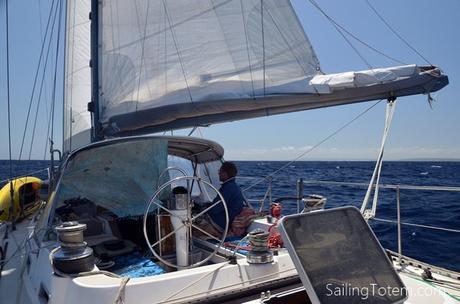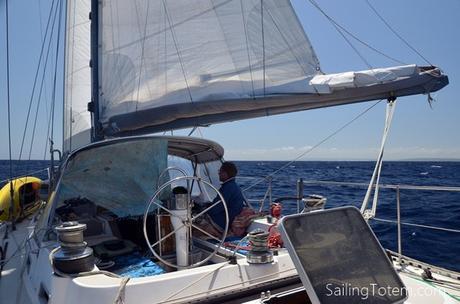

This post comes from Jamie, one in a series where he shares his knowledge as a tenured sailmaker. For more about Jamie’s experience in the field, see Sailmaker SAYS!.
My friend just bought a new mainsail and the foot isn’t attached to the boom. Her sailmaker said it’s the way to go, but I’m not convinced? Forever the skeptic, but I understand your concern because sailmakers are easily confused. So it is a bad idea, thought so. Actually, her sailmaker is right. Oh…
Grey MattersFoot: the bottom edge of a sail.Loosefoot: This refers to a mainsail with foot not attached to the boom. The tack and clew secure the lower sail in place, and the foot floats freely.
Attached foot: A mainsail with foot secured to the boom by slides, slugs, or boltrope.
An attached foot is another example of, “because it’s always been done that way” sailmaking. Back in the ancient times, before Dacron, sailcloth was wicked stretchy. A flat mainsail got deeper with increasing wind. By attaching the foot to a sturdy boom, the sail would grow too wicked baggy; but a loosefooted main, back in the day, could take on a balloon like shape.
Those were the dark ages of sailmaking. Whoa, I never knew… Dacron, known in the fashion world as Polyester, was invented by DuPont and heralded a new, modern era of moderately stretchy sails. Though a significant improvement, mainsail features didn’t change. Eventually though, a sailmaker somewhere built a loosefooted mainsail – meaning he probably forgot the foot slides and then upon realizing boasted of a clever new innovation! A sailmaker mistake, I didn’t think that was possible. No,no, you have us confused with riggers. They never make mistakes…
Hahahahahahahahahahahahahahahahahahahaha! Sorry, just a little industry humor.
Anyway, it turns out that a loosefoot has advantages. For one, it’s a little easier to bend the mainsail on if you have only to attach tack and clew, and not a bunch of foot hardware. More importantly, sail shape low in the sail is better with a loosefoot. When the foot is attached, sail depth gets pulled out; no lift generating foil shape. Ever see a flat airplane wing? Ah, no. Well, a two dimensional sail doesn’t work either. Loosefooted, sail shape retains good wing like shape along the foot. We used to build attached foot mains with a lens shaped panel to solve this, but it still wasn’t perfect and added time and cost to a sail. Something sailmakers are good at!
Yeah, yeah, but I’m telling you that loosefoot has no foot hardware, which means less cost. And the simplicity of it has advantages. You see, some sailmakers use shackles to attach foot hardware. They make noise banging against the boom; and are either plastic, which will rot in the sun, or metal, which will scratch the boom.
Wow, a loosefooted main really makes sense. What about mizzens? Yeah, same. Wait, hold on. Doesn’t the attached sail, main or mizzen, give strength to the boom? No.
But the…. No.
But I read on the intern… No! Look, a boom is aluminum or wood or even carbon fiber for the lucky ones. It’s rigid! Well, wood is a bit bendy, but generally very stiff. A sail has stretch. And even if it didn’t, let’s say you have a carbon fiber mainsail, lucky bastard, it has shape. You remember the part about airplane wing right? Yes, yes. Sail shape, depth, means sailcloth isn’t taught enough to counter forces on a boom, such as mid boom sheeting. And it probably made of stretchy Dacron. Take a pencil and tape plastic to it like a boom and sail. Now make the plastic a little baggy and then see if it prevents the pencil from breaking when you apply force to the middle, with ends secured. Snap.
Is there any scenario where an attached foot is the way to go? Yes, if the sailcloth is Egyptian cotton. Oh, and if you want to take one of those photos sitting atop the boom while sailing downwind. People do that? Yeah, that’s something a rigger would do. Funny.
Totem is somewhere in the Atlantic, hopefully between Ascension and Barbados, if things haven’t gone horribly wrong. Find our current position and speed here! We will get comments at sea, so add a little interest to our day out in the big blue. We’ll be able to respond after we reach the Caribbean in late April.

